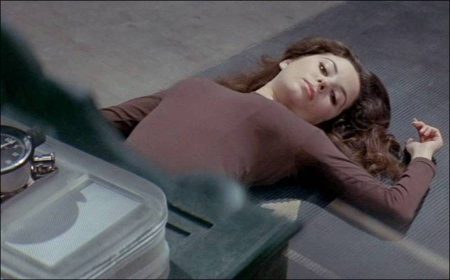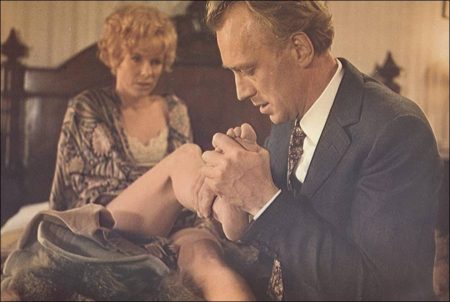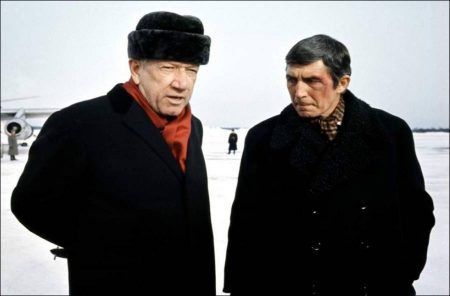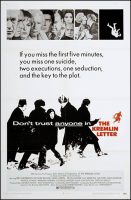Taglines: Don’t trust anyone in The Kremlin Letter.
The Kremlin Letter movie synopsis. An American intelligence officer signs an agreement with the Soviet Union stating that both countries will attack China, and the U. S. government hastily assembles a group of espionage agents to recover the unauthorized treaty called the “Kremlin Letter.”
The team, under the leadership of The Highwayman, consists of Rone, a retired U. S. Navy officer; B. A., a safecracker’s daughter who replaces her ailing father on the mission; Janis, a small-time pimp from a Mexican brothel; The Warlock, a transvestite found in a San Francisco gay bar; and Ward, The Highwayman’s top assistant.
In New York, the Americans have a lesbian seduce the daughter of U. S.-based Russian spy Potkin in order to blackmail him into turning over his Moscow apartment as a base for their operations. In Moscow, they bug the residence of Secret Police Chief Kosnov, who is married to Erika, the widow of an enemy spy; Kosnov is currently engaged in a power struggle with political leader Aleksei Bresnavitch. Meanwhile, B. A., who has become Rone’s lover, is captured by Bresnavitch. When Ward temporarily leaves the country, Potkin confesses to Bresnavitch what has happened.

Bresnavitch has another problem, however: Rone has discovered that he (Bresnavitch) is a traitor and that the Kremlin Letter is in Peking. Ward is also revealed to be a traitor, working for Bresnavitch. Upon his return, Ward kills Erika, who had devised a plan to sneak Rone out of Russia, and at the airport, he also murders Kosnov, an old friend who had doublecrossed him several years before. By now Rone is ready to retire, but Ward will release B. A. only if Rone will return to the United States for one more mission–to murder Potkin’s wife and daughter.
The Kremlin Letter is a 1970 American neo-noir DeLuxe Color espionage thriller in Panavision directed by John Huston and starring Richard Boone, Orson Welles, Max von Sydow, Bibi Andersson, Patrick O’Neal and George Sanders. It was released in February 1970 by 20th Century-Fox.
The screenplay was co-written by Huston and Gladys Hill as a faithful adaptation of the novel by Noel Behn, who had worked for the United States Army’s Counterintelligence Corps. Said by reviewers to be “beautifully” and “engagingly” photographed, the film is a highly complex and realistic tale of bitter intrigue and espionage set in the winter of 1969–1970 at the height of the US-Soviet Cold War.
The Kremlin Letter was a commercial failure and thinly reviewed in 1970, but the film has gathered steady praise from some critics throughout the decades since its release. French filmmaker Jean-Pierre Melville called The Kremlin Letter “masterly” and “…saw it as establishing the standard for cinema.”
About the Film
An American official sends a letter about China to the Kremlin and it must be gotten back because of its explosiveness and lack of authorization. This is the nub of Noel Behn’s novel.
The story in cinematic form is a conglomerate of scenes, each of which makes for valuable viewing, but with the piecing together another thing. Thus is this nastiness of the spy business graphically described. It is an engagingly photographed piece of business.
Max von Sydow is a political strong man within the Russian regime. Ex-US Navy officer Patrick O’Neal has the job of salvaging the Kremlin Letter. But Russia, in the person of Richard Boone, also would like to retrieve the document. Participants include George Sanders, as a homo female impersonator in San Francisco. Orson Welles is a key Soviet man who is in New York to address the United Nations; Bibi Andersson is a prostitute married to agent Von Sydow.
The film shows its characters speaking Russian without the use of English subtitles by either having the characters speaking Russian while supplying simultaneous voiced-over English translation or else beginning such scenes in Russian and then segueing into English. Many of the scenes set in Moscow were filmed during 1969 in the Finnish capital city of Helsinki which features neoclassical buildings similar to those in Leningrad.
There was also filming at locations in New York City (the Hispanic Society of America, Central Park Zoo and Greenwich Village), Italy and Mexico. Mostly aerial stock footage from the summer of 1969 showing Los Angeles, San Francisco, Chicago and New York City is also seen in the film. According to Fox records the film required $10,100,000 in rentals to break even and by December 11, 1970 had made $3,425,000. By September 1970 the studio recorded a loss of $3,939,000 on the film to the studio.
The Kremlin Letter (1970)
Directed by: John Huston
Starring: Bibi Andersson, Richard Boone, Nigel Green, Dean Jagger, Patrick O’Neal, George Sanders, Max von Sydow, Orson Welles
Screenplay by: John Huston, Gladys Hill, Barbara Parkins
Production Design by: Ted Haworth
Cinematography by: Edward Scaife
Film Editing by: Russell Lloyd
Costume Design by: Dario Simoni
Set Decoration by: John Furniss
Art Direction by: Elven Webb
Music by: Robert Jackson Drasnin
MPAA Rating: None.
Distributed by: 20th Century Fox
Release Date: February 1, 1970
Views: 240


